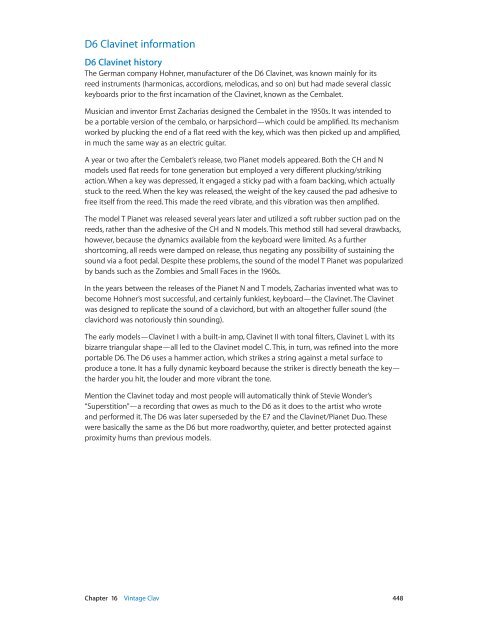Apple MainStage 3 Instruments - MainStage 3 Instruments
Apple MainStage 3 Instruments - MainStage 3 Instruments
Apple MainStage 3 Instruments - MainStage 3 Instruments
You also want an ePaper? Increase the reach of your titles
YUMPU automatically turns print PDFs into web optimized ePapers that Google loves.
D6 Clavinet information<br />
D6 Clavinet history<br />
The German company Hohner, manufacturer of the D6 Clavinet, was known mainly for its<br />
reed instruments (harmonicas, accordions, melodicas, and so on) but had made several classic<br />
keyboards prior to the first incarnation of the Clavinet, known as the Cembalet.<br />
Musician and inventor Ernst Zacharias designed the Cembalet in the 1950s. It was intended to<br />
be a portable version of the cembalo, or harpsichord—which could be amplified. Its mechanism<br />
worked by plucking the end of a flat reed with the key, which was then picked up and amplified,<br />
in much the same way as an electric guitar.<br />
A year or two after the Cembalet’s release, two Pianet models appeared. Both the CH and N<br />
models used flat reeds for tone generation but employed a very different plucking/striking<br />
action. When a key was depressed, it engaged a sticky pad with a foam backing, which actually<br />
stuck to the reed. When the key was released, the weight of the key caused the pad adhesive to<br />
free itself from the reed. This made the reed vibrate, and this vibration was then amplified.<br />
The model T Pianet was released several years later and utilized a soft rubber suction pad on the<br />
reeds, rather than the adhesive of the CH and N models. This method still had several drawbacks,<br />
however, because the dynamics available from the keyboard were limited. As a further<br />
shortcoming, all reeds were damped on release, thus negating any possibility of sustaining the<br />
sound via a foot pedal. Despite these problems, the sound of the model T Pianet was popularized<br />
by bands such as the Zombies and Small Faces in the 1960s.<br />
In the years between the releases of the Pianet N and T models, Zacharias invented what was to<br />
become Hohner’s most successful, and certainly funkiest, keyboard—the Clavinet. The Clavinet<br />
was designed to replicate the sound of a clavichord, but with an altogether fuller sound (the<br />
clavichord was notoriously thin sounding).<br />
The early models—Clavinet I with a built-in amp, Clavinet II with tonal filters, Clavinet L with its<br />
bizarre triangular shape—all led to the Clavinet model C. This, in turn, was refined into the more<br />
portable D6. The D6 uses a hammer action, which strikes a string against a metal surface to<br />
produce a tone. It has a fully dynamic keyboard because the striker is directly beneath the key—<br />
the harder you hit, the louder and more vibrant the tone.<br />
Mention the Clavinet today and most people will automatically think of Stevie Wonder’s<br />
“Superstition”—a recording that owes as much to the D6 as it does to the artist who wrote<br />
and performed it. The D6 was later superseded by the E7 and the Clavinet/Pianet Duo. These<br />
were basically the same as the D6 but more roadworthy, quieter, and better protected against<br />
proximity hums than previous models.<br />
Chapter 16 Vintage Clav 448
















